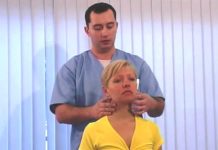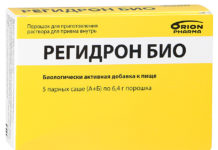The red brush or rhodiola is four-parted - a medicinal plant of the family Crassulaceae. It grows in Altai and in the Sayan Mountains. The red brush, the medicinal properties and contraindications of which were studied in the 18th century by the German and Russian natural scientists P.S. Pallas was widely used in oriental medicine. Long before the plant was systematized and described in botanical treatises, it was used by Altai healers.
Material Content:
Red brush: healing properties for women
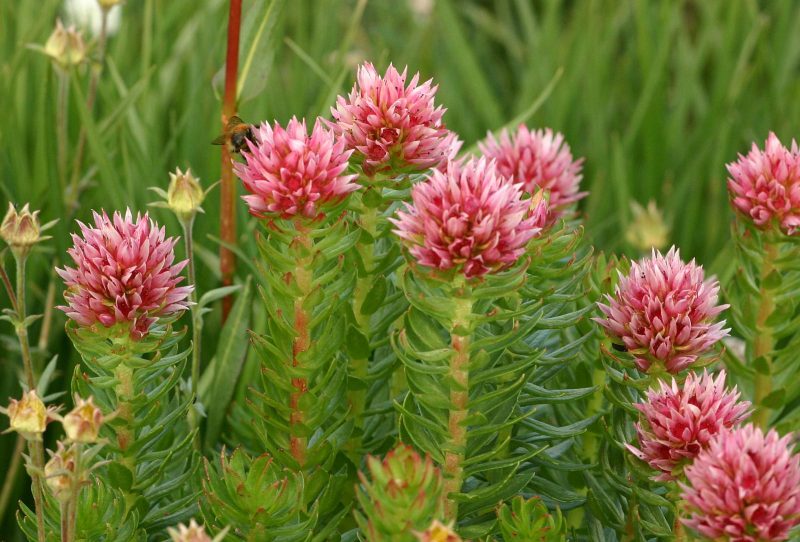
Drugs from rhodiola four-part extract are used in therapy:
- female reproductive system (mastopathy, infertility, fibroids);
- male reproductive system (adenomas and prostatic hyperplasia, oligospermia, male infertility);
- endocrine system (toxic goiter, adrenal gland diseases).
Grass red brush is popularly called Siberian ginseng for a mild tonic effect, adaptogenic and immunostimulating properties.
The multicomponent composition of the plant, in which there are unique substances that are characteristic only for it, also determines the multidirectional, multifunctional effect of rhodiola.
The extract obtained from the roots and rhizomes of the red brush has a pronounced effect:
- anti-inflammatory;
- antibacterial;
- immunostimulating;
- hemostatic;
- normalizes metabolic processes and hormonal balance;
- improves energy metabolism in muscle tissue and the central nervous system.
In official and traditional medicine, the red brush root is used, since it is in it that the plant “stores” the maximum amount of active substances.
- Anthocyanins are substances that cause the color of parts of a plant. They have an antiviral, antimycotic effect, reduce inflammatory reactions and oxidative stress in the intestine, and increase the barrier functions of the gastrointestinal tract.
- Antraglycosides - accelerate the promotion of the contents of the gastrointestinal tract, have laxative properties.
- Sterols - reduce the concentration of cholesterol in the blood, block autoimmune reactions, improve the functions of the cardiovascular system.
- Flavonoids - a large group of substances that have anti-tumor, angioprotective (protects and strengthens blood vessels), antihypertensive effect.
- Tannins - have astringent, reparative, anti-inflammatory properties.
- Essential oils - natural antiseptic, immunomodulator, bacteriostatic.
- Organic acids - normalize metabolism, improve trophic tissue, reduce the level of "bad" cholesterol, stimulate blood formation.
One of the main bioactive substances of rhodiola - salidroside glycoside has an oncoprotective, anti-inflammatory, anti-infective and adaptogenic effect.
In addition, in Rhodiola contains a significant amount of trace elements:
- manganese;
- chromium;
- nickel;
- molybdenum;
- silver;
- zinc;
- cobalt.
In recent decades, scientists from Russia, Japan, and Germany began to study the properties of the red brush. The Russian pharmaceutical industry has already released a number of phytopreparations based on rhodiola four-divided. For example, herbal tea and dragees from the company "HORST" (Russia, Moscow), used to treat gynecological pathologies. And the Artlife company (Ukraine, Nikolaev) produces the Energia phytocomplex to normalize metabolic processes.
Promising results from the clinical use of Rhodiola quadrifida have been received by researchers from Poland. They tested the effectiveness of the use of alcohol tinctures of plant roots for cancer.
It was also found that the red brush is an effective tool for diseases of the cardiovascular system, anemia, leukemia.
What female diseases helps?
The red brush contains phytohormones and phytoestrogens, similar in structure and function to sex hormones. Thanks to them, the red brush is used in the treatment of a large number of gynecological pathologies caused by an imbalance of hormones.
Phytoestrogens:
- reduce the proliferation (growth and reproduction) of cells, especially atypical (altered) in hormone-dependent tissues of the reproductive system and mammary glands;
- stimulate the activity of prostaglandins H-synthetase, which has an antitumor effect;
- bind to the corresponding estrogen-sensitive receptors in the tissues.
In contrast, phytohormones do not bind to receptors. But they favorably affect the function of the hypothalamus - they reduce the production of luteinizing hormone, serotonin, and have organ selectivity.
The use of red brush preparations in female diseases is justified by a number of clinical studies of domestic and foreign scientists.
Ovarian cyst

The causes of the appearance of ovarian cysts are not fully understood, but most scientists are inclined to the version according to which the main factors for the occurrence of benign neoplasms are:
- hormonal imbalance caused by dysfunction of the endocrine glands and reproductive system;
- inflammatory processes of the pelvic organs;
- apoptosis - programmed cell death.
The effectiveness of therapy for ovarian cysts with red brush preparations is due to the complex effect of active substances that eliminate these factors. They:
- normalize hormonal homeostasis;
- stimulate the production of anti-inflammatory cytokines;
- have antibacterial and antiseptic effects;
- inhibit apoptosis and provide tissue regeneration.
Four-part Rhodiola preparations in the treatment of ovarian cysts are used orally, and to increase effectiveness even locally for douching. When treating with a red brush, the cyst resolves within 3-6 months.
Herbal medicine also reduces the risk of malignant degeneration of the cyst.
For systemic therapy, alcoholic infusion of the root of Rhodiola four-divided is used.
- Take 30 drops of tincture 3 times a day.
- After taking, you should not drink and eat for 40 minutes.
- The duration of the course of therapy is 30 days.
- Then take a break for 2 weeks and repeat the treatment until complete recovery.
For douching, use alcohol tincture diluted with water (1 teaspoon per 0.5 liter of warm water) or a decoction of the roots of the red brush. The procedure is carried out 2 times a day for 7-10 days.
Endometriosis
Endometriosis is a hormone-dependent pathology in women. The main cause of the disease is a violation of the function of the hypothalamic-pituitary system, which leads to a change in the work and structure of the ovaries.

The use of red brush preparations eliminates violations:
- dishormonal;
- inflammatory;
- immune
- psycho-emotional.
For the treatment of endometriosis apply:
- Douching with a solution of infusion of the roots of the plant. The procedure is carried out twice a day for 25 minutes. Within 2 weeks.
- Reception of the broth 1/3 cup three times a day. The course of treatment is 45 days.
- Alcohol tincture of the roots. Take 35 drops 3 times a day. The course of treatment is 1 month. Between courses take a break of 2 weeks.
- Decoctions of a red brush and a hog uterus. 2 decoctions are prepared from dry raw materials. Begin treatment with a decoction of the uterus. Then take a break for the period of menstruation. After the end of the monthly cycle, take a decoction of the red brush.
People's advice:Pine uterus: medicinal properties and contraindications
The course of treatment of endometriosis with phytopreparations is from 2 to 6 monthly cycles, depending on the size of the lesion, the level of hormones (LH, FSH, prolactin) and the general condition of the woman.
Erosion
Cervical erosion is a violation of the integrity of the integumentary epithelium on the outer part of the cervix. Such a diagnosis is made to every 3 women of childbearing age. True erosion is treated promptly (by laser, current or radio wave method). But at the initial stage of true erosion or with pseudo-erosion, red brush preparations, which are used for douching, can also remove inflammation and balance the hormonal background. The course of treatment is the same as with endometriosis.

Polycystic Ovary
The formation of numerous benign tumors in the ovaries, which disrupt the ovulation process, is diagnosed as polycystic ovary. With pathology, there is a violation of the hormonal background - a decrease in the production of follicle-stimulating hormone against the background of normal activity of estrogen and progesterone.
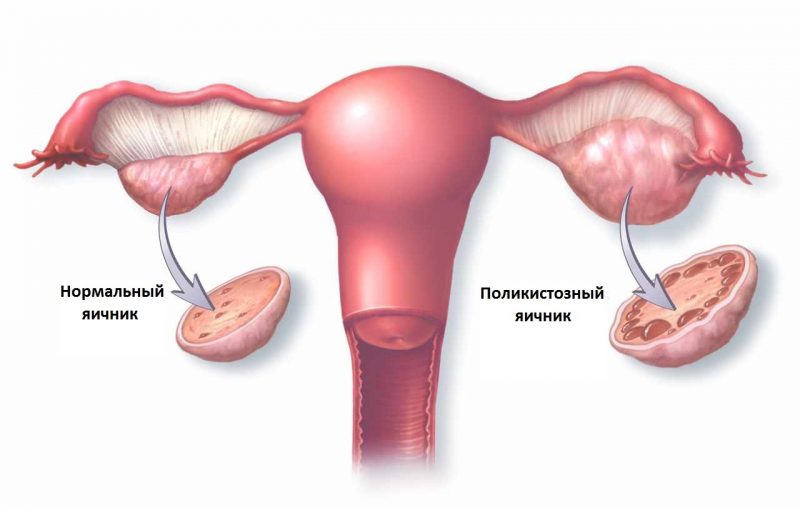
A red brush normalizes androgen levels. Clinical studies have shown that the use of an alcoholic extract of the roots of Rhodiola quadripartite eliminates follicular cysts, normalizes hormonal homeostasis. The use of the drug in a three-week course, excluding the period of menstruation, reduces the severity of pathological symptoms by 98% and ensures resorption of cysts in 79-82% of cases.
Cervical Polyps
Polyps are benign tumors caused by hyperplasia of the cervical mucosa.
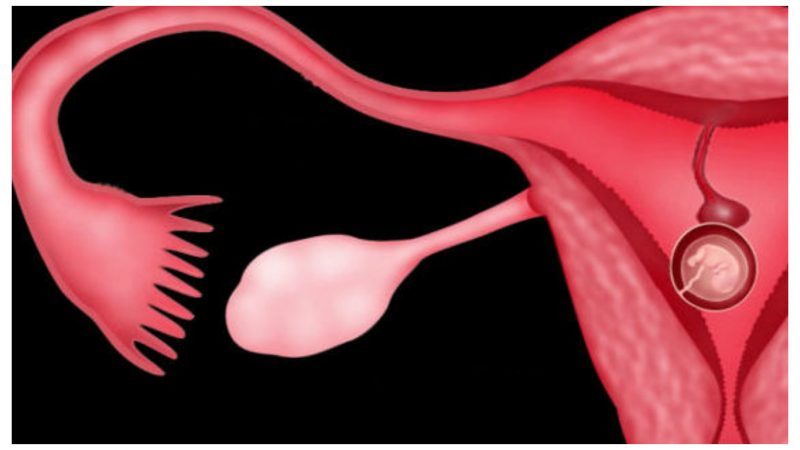
The cause of the pathology is:
- increased estrogen activity;
- decreased immunity;
- thyroid dysfunction;
- gynecological pathologies - endometritis and adnexitis.
Red brush preparations normalize the level of sex hormones and affect the function of the thyroid gland. Studies of domestic immunologists E.Skopinskaya-Rozhevskaya and M. Buchavskaya proved that the red brush treats not only dishormonal and inflammatory processes, but also increases the nonspecific resistance of the body to adverse factors.
To treat polyps of the cervix, an alcoholic infusion and a decoction of the roots of the plant are used.
Endometritis
Endometritis is an inflammation of the endometrium caused by infection from the vagina.
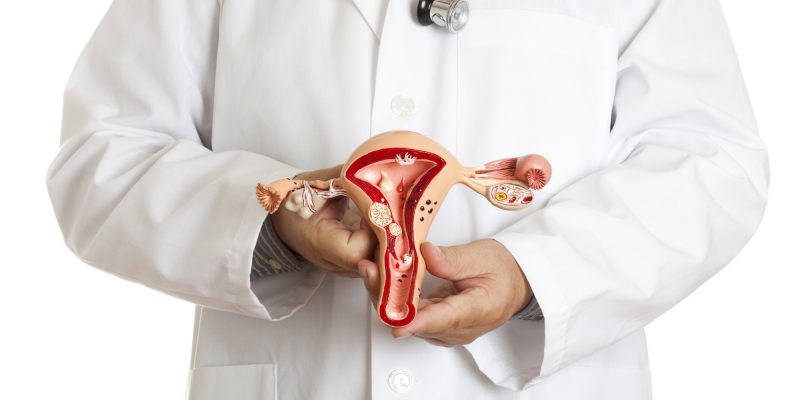
The use of a red brush contributes to:
- relief of pain;
- increase immunity;
- the production of interferons;
- stimulation of metabolic processes that ensure the regeneration of damaged epithelium;
- activation of blood flow;
- the destruction of pathogenic microflora;
- relieve inflammation.
For treatment, tincture of the red brush is used orally and for douching.
With menopause
Menopause or menopause is the process of natural extinction of reproductive function.

Climax is accompanied by a violation of physiological and psychological processes in the female body:
- increased blood pressure;
- violation or absence of the menstrual cycle;
- mood swings, depression, irritability;
- sleep disturbance;
- fatigue;
- headaches, sweating, hot flashes.
The red brush eliminates all the symptoms of menopause, normalizes estrogen levels and, in addition:
- helps to eliminate toxins and metabolic products from the body;
- provides prevention of cardiovascular and metabolic pathologies, atherosclerosis, urogenital disorders;
- restores vaginal lactoflora;
- relieves inflammatory processes;
- prevents the development of tumors in the mammary gland and uterus;
- contributes to the elimination of psycho-emotional disorders.
In a double-blind study conducted in a clinical hospital in Moscow, the positive effects of red brush preparations even on bone remodeling were proven.
Female infertility
Female infertility is caused by various pathological processes in the reproductive system, a violation of hormonal homeostasis and other factors.

In the Altai Medical Center, clinical studies have been conducted on the effectiveness of the treatment of various forms of infertility with rhodiola four-parted and one-sided (boron uterus) drugs.
Infertility treatment with these herbal remedies significantly increased the percentage of pregnancy, its successful resolution and reduced the level of reproductive loss by 2 times compared with the control.
Red brush for cancer in women
The red brush is used to prevent and treat gynecological precancerous diseases and malignant processes of the female reproductive system.
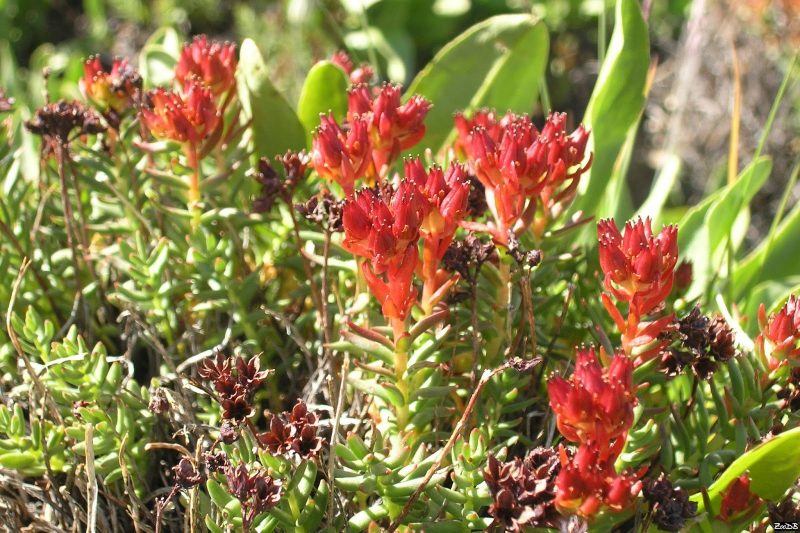
So, the mammary gland depends on the influence of sex hormones. Her condition is associated with the menstrual cycle and the mechanism of its regulation.
In addition to dishormonal conditions, the development of cancer can contribute to:
- metabolic disorders;
- stress
- abortion;
- bad habits;
- heredity.
The red brush, according to the research of A.T. Troshchenko, G.A. Kutikova, M. Malinowski, and A. Wasyutinsky, is a natural oncoprotector and has an antitumor effect due to the content of salidroside in it.
Uterine fibroids
Hypertrophy of the muscle tissue of the uterus is a pathological condition called myoma.

The following factors cause the disease:
- the effect of prolonged psycho-emotional overload and stress;
- hypothyroidism;
- chronic inflammation and infectious diseases of the reproductive system;
- taking oral contraceptives and hormonal drugs.
When examining the body of a woman with a uterine myoma, an increased level of estrogen is detected. The disease is precancerous and requires adequate and timely treatment. As a maintenance therapy, a red brush decoction is used, which is used for douching and systemic treatment.Inside take a decoction of 1 tbsp. l thrice a day.
Mastopathy
Most scientists believe that the main cause of mastopathy is an imbalance of female hormones - an increase in the activity of estrogens with hypofunction of progesterone. Excess prolactin also has an adverse effect on the ratio of glandular tissue and parenchyma.
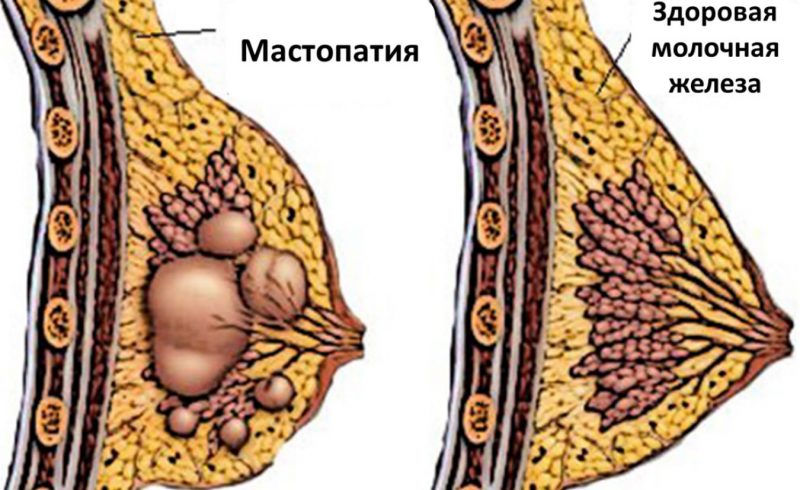
For the treatment of mastopathy used:
- alcohol tincture of a red brush inside of 30 drops three times a day;
- compresses on the chest are prepared from tincture diluted with warm water.
With regular use of tincture, 12% of women experience a complete regression of small tumors. In the remaining patients, rhodiola preparations caused:
- normalization of hormonal homeostasis;
- a decrease in the severity of the symptoms of the disease;
- significant improvement in the psycho-emotional state;
- reverse development of cystic formations in the chest.
Uterine Fibroma
A high estrogen level causes connective tissue hyperplasia in the uterus, diagnosed as fibromyoma.
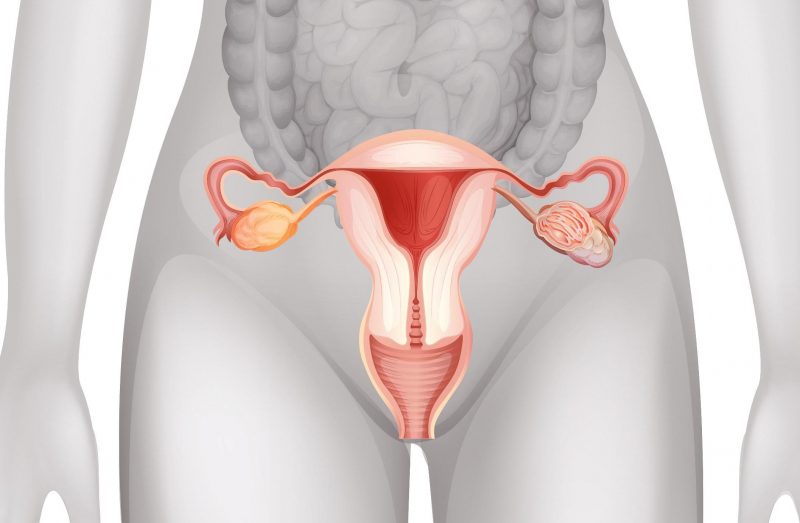
Factors that increase the risk of the disease are:
- heart and vascular diseases;
- therapy with estrogen-containing drugs;
- genetic predisposition.
Alcohol tincture of the red brush eliminates inflammatory processes, increases the body's resistance and local immunity, normalizes hormonal levels and strengthens the walls of blood vessels. Tincture is taken orally for 3-5 months and as a solution for douching.
Tincture of the red brush: instructions for use
It is recommended to prepare alcohol tincture not on vodka, but on 40% alcohol. For tincture, take 50 g of fresh or dry Rhodiola four-root root, cut it into small pieces and pour ½ liter of alcohol. Withstand tincture without access to light for 30 days, shaking regularly.
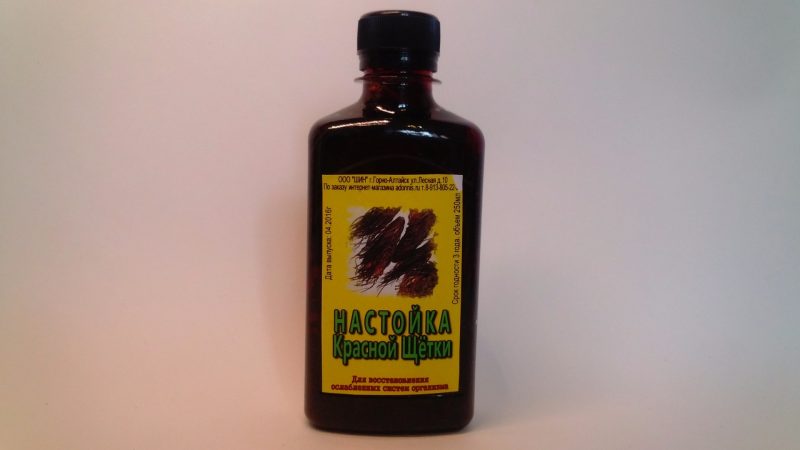
Take 30-40 drops of tincture 3 times a day for 20-30 minutes before meals. The course of treatment is 30 days. Between courses you need to take two-week breaks.
Proper use of the decoction
When preparing a decoction of a red brush, you can not fill the root with boiling water.
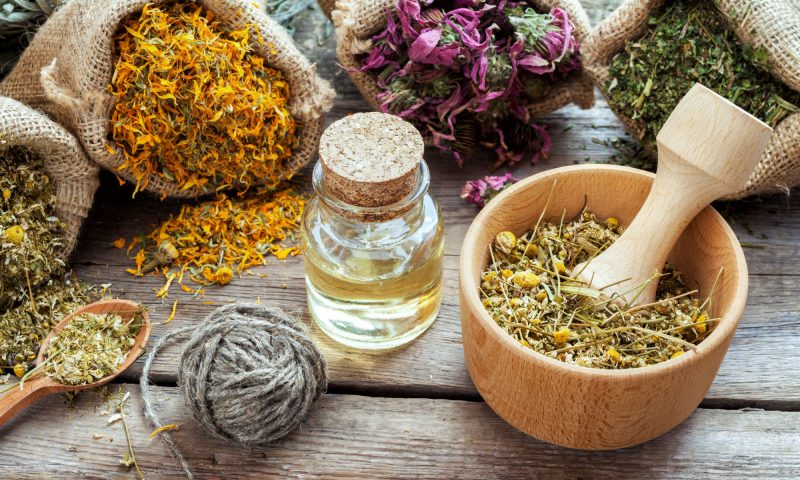
Dry root is crushed, take 1 tbsp. l raw materials and pour 300 ml. cold water. The broth is brought to a boil and boiled for 5-10 minutes. The container is closed and the broth is infused for 60 minutes.
A strained warm broth is taken 1/3 cup three times a day half an hour before a meal. The course of treatment is 1.5-2 months.
To prepare a solution for douching, 1 cup of broth is diluted with ½ liter of boiled warm water. Irrigation is carried out twice a day. The duration of the procedure is 15-20 minutes. Douching is used for 7 days. If necessary, repeat the procedure.
Drugs are not recommended before bedtime, as the red brush has a tonic effect.
Which is better, a red brush or a hog uterus?
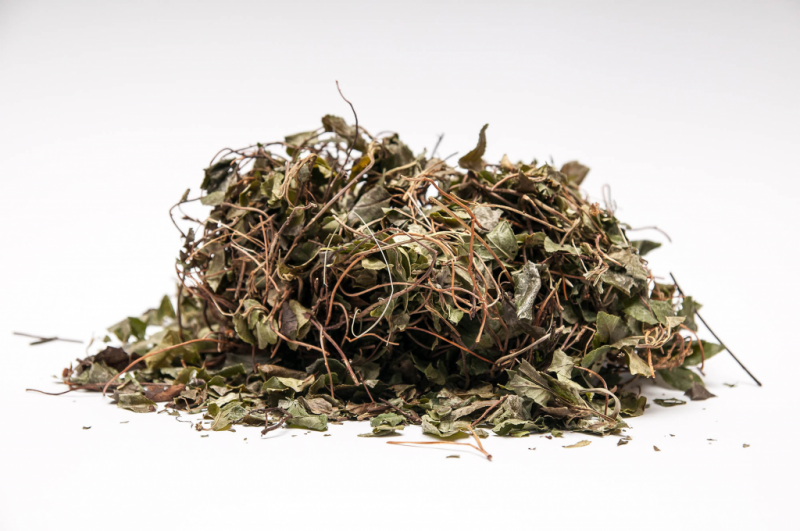
To increase the effectiveness of the treatment of gynecological diseases, especially neoplasms, red brush and boron uterus preparations are used. Orthilia is one-sided (boron uterus) also contains phytohormones, which leads to the same indications for use as the red brush, but the boron uterus is not used when there is a threat of uterine bleeding. Joint use of plants enhances the effect of each.
Side effects
Subject to dosage and duration of the course of therapy, there are no side effects. Taking drugs can cause an allergic reaction.

At the beginning of the course of treatment, some patients experience drowsiness and slow down reactions. With continued use, these effects disappear. In clinical studies, patients were well tolerated.
Contraindications

Four-part Rhodiola preparations are not recommended for use with:
- high blood pressure (above 180/100);
- individual intolerance to the plant;
- feverish conditions;
- nervous overexcitation;
- pregnancy and lactation;
- menstruation (the exception is heavy bleeding).
During therapy with red brush preparations, do not drink alcohol and follow a diet low in fat. It is forbidden to use rhodiola preparations and hormonal drugs (synthetic or plant phytohormones) in parallel.
Rhodiola preparations have a pronounced systemic effect, so their reception must be agreed with the attending physician.







